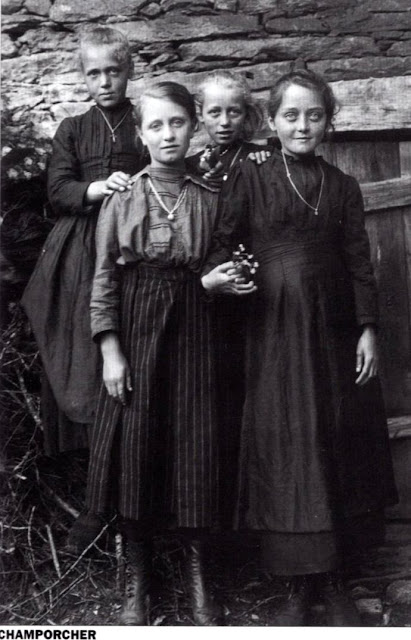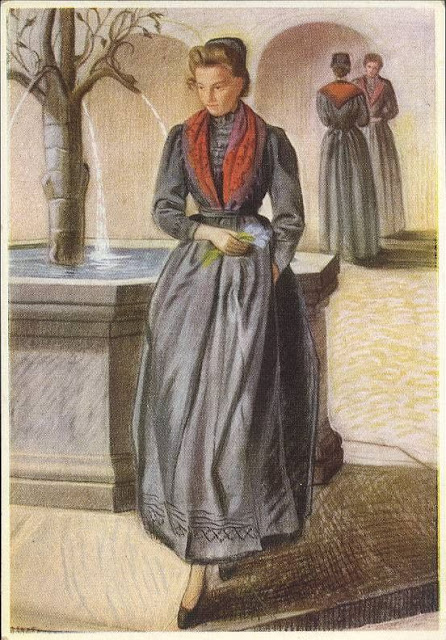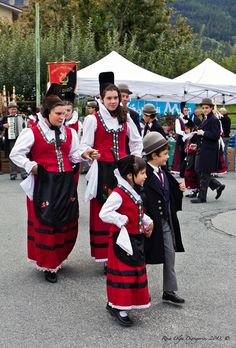Hello all,
Today I will cover the costumes of the Aosta Valley, in Italian Valle d'Aosta, in French Val d'Aoste, in the local language Val d'Outa.
https://en.wikipedia.org/wiki/Aosta_Valley
This is currently located in the extreme northwest corner of Italy. Historically, however, it was part of the Duchy of Savoy, and the people are mostly Savoyard in origin. Thus, they identify at least as much with France as with Italy. The ancestral native language of the majority of the population is Valdôtain, a dialect of Arpitan.
https://en.wikipedia.org/wiki/Vald%C3%B4tain_dialect
Education is in both French and Italian, and about half of the population can speak all three languages. There is a small minority of Walser Germans in the northeast, who speak a couple different dialects of High Allemanic. These consist of the residents of the villages of Gressoney-Saint-Jean, Gressoney-La-Trinité and Issime, in the Lys Valley. They originally migrated south from Valais in Switzerland.
https://en.wikipedia.org/wiki/Walser_German
As you can see, Aosta is bordered by French Switzerland on the north, France on the west, and the Italian Paese of Piedmont on the east and south. It consists of a the valley of the Dora Baltea [Doire Baltée, Djouire] river, which starts on the slopes of Mt. Blanc, and winds its way to the southeast. There are a number of side valleys, wherein the majority of the communities with a costume tradition are found.
Here is a physical map to show you the various valleys, and a map which pinpoints various communities.
This map was made by Daniel Feher. You can see his original work at this website:
http://www.freeworldmaps.net/europe/italy/aostavalley.html
Lys River Valley
This is the first valley on the east side of Aosta, which flows to the south. We will look at the communities starting at the head odf the valley.
Gressoney
This consists of two communites in the upper Lys valley, Gressoney-La-Trinité, In Walser - Greschòney Drifaltigkeit, and Gressoney-Saint-Jean, in Walser - Greschòney Zer Chilchu.
These communities are Walser German in origin, and basically share the same costume. This is likely the best known folk costume of Aosta.
Issime, Éischeme
This town is found a short way downstream from Gaby. The two used to form one municipality in spite of the difference of ethnicity and language. Issime speaks its own dialect of Walser German.
Fontainemore, Fontènemore
This community is traditionally the edge of the Valdotain speaking area, being found downstream from Issime.
Lillianes
This is found a short way downstream in the same valley.
Perloz, Pèrlo
This is found almost at the mouth of the Lys valley.
Lower Aosta valley
Pont-Saint-Martin, Pon Sèn Marteun, Pont San Martìn
This town is found on the central valley of Aosta right next to the border. Of the three forms of the name above, the second is in Valdotain, and the third is in Piedmontese, which is actually more commonly spoken in this town. This town is actually named after the bridge.
Donnas, Dounàs
Champorcher, Tsamportsé
This community is found in the side valley of the Ayasse river, which flows into the main valley from the southwest. It is well known for artisanal production of objects made of wood.
Issogne, Issoueugne
This is a short distance upstream in the main valley on the west side.
Verrès, Verrèts
This is on the east side of the river, basically right across from Issogne. This town is famous for its medieval festival.
Évançon River Valley
This is the second river valley which empties into the main valley of Aosta from the north.
Brusson, Breutson
This community is found relatively low in the valley.
Ayas, Ayâs
The upper reaches of this valley form the municipality of Ayas. This area is known for the production and wearing of Sabot to the present day.
Champoluc
This is a village in the upper reaches of the valley.
Marmore River Valley
Torgnon, Torgnòn
This village is in the lower reaches of the valley on the west side.
La Magdeleine
This village is found somewhat further up the valley on the east side.
Valtournenche
This municipality lies in the mid to upper reaches of the valley. The valley is usually called after this town.
Breuil-Cervinia
This village lies at the very head of the valley. It is a well known ski resort.
Middle Aosta Valley
The middle run of the valley runs almost directly east-west.
Saint-Vincent, Sèn-Veuncein
This town is located at the point where the valley bends to west as one ascends it. It is known for hot springs and Roman ruins.
Châtillon, Tsâteillon
This town is a short distance upstream, about even with the mouth of the Marmore.
Charvensod, Tsarveunsoù
This town lies on the south side of the valley further upstream.
Aosta City
This is the capitol of the region, located about where the river takes another bend. There appear to be two headdresses associated with the city, one rather box shaped, and the other a high confection of black lace.
North Central Aosta
Valpelline
This is a side valley which lies to the north of Aosta City. It is named after the largest community up in the valley. The river is also called Valpelline, or Bouthier. It angles to the east at its head.
This outfit is from the village of
Bionaz.
Valle del Gran san Bernardo
This is a valley which leads from the mid Valpelline to the northwest, ending in the St. Bernard Pass which leads into Switzerland.
The following two outfits are from the combined village of
Saint-Rhémy-en-Bosses, Sèn Rémi eun Boursa
Valdigne, Upper Aosta Valley
As you move upstream from the city of Aosta, the river bends once more, and the valley proceeds to the northwest. This part of the valley is called Valdigne.
La Salle, La Sala
There is a break as you head upstream, after which you come to this town. The most distinctive part of this costume is the upright white lace headdress.
Video of a dance group from La Salle.
https://www.youtube.com/watch?v=6w2HZ3tSe5M
Morgex, Mordzé
Video of a dance from Morgex.
https://www.youtube.com/watch?v=uO3o465oq_A
Pré-Saint-Didier, Pré-Sèn-Lédjé
This is yet further up the valley.
Courmayeur, Croméyeui
This community lies at the head of the main valley.
A video of a group from Courmayeur doing the Monferrina.
https://www.youtube.com/watch?v=D2ZgwWbMZ5k&t=16s
Val Veny, Val Vény
This is small side valley to the south of Courmayeur.
Southwest Aosta
There are a few isolated communities in this part of Aosta. They are rather remote and far apart, and each is found in its own side valley.
La Thuile, La Tchoueuille
This town is found in a side valley between Pré-Saint-Didier and the current French border. At the head of the valley is a pass which leads to Bourg-Saint-Maurice in the Tarantaise valley in French held Savoy. The local dialect is closer to those found on the French side of the border. The men's costume in particular is much closer to the French ones.
Cogne
Cogne is found in an isolated side valley south of Aosta. This is likely the second most famous costume of the area, and it is featured at the head of the article. The costume of this community at first glace seems very different from the others in the area; however it is actually a development of the older costume which was one found throughout Aosta. In many of the other locations there was a shift to finer, more manufactured materials. This did not happen here, the costume is still made from a very heavy home woven black wool. In addition, the dress is formed and pleated so as to exaggerate the width of it. The apron is usually worn folded up, as in parts of Valsesia.
This community is also famous for its bobbin lace.
I will have to do a more in depth article on this costume.
A couple of videos about the costume and dance of Cogne.
https://www.youtube.com/watch?v=oWO2WJdrL2A
https://www.youtube.com/watch?v=K1NKq7FyY-o
Thank you for reading. This concludes my overview of the costumes of Aosta. I hope that you have found this to be interesting and enlightening.
Roman K.
email: rkozakand@aol.com
Source Material:
Stefania Massari et al, 'Abiti', Aosta, 2008
Giovanni Thoux, 'Costumi Valdostani Scavati nel Legno', Torino, 2001
Theresa Charles et al, 'Costume di Tradizione di Cogne', Aosta, 1997
Giorgio Vassoney, 'Le Costume di Cogne', Aosta, 1991
Emma Calderini, 'Il Costume Popolare in Italia', Milano, MCMLII



























































































































































